Successfully launching a mobile commerce app in today’s market is a challenge in itself. With countless apps available, increasing user expectations, and cybercriminals constantly looking for ways to exploit data, the competition is fierce.
At the same time, mobile commerce is a niche with immense potential. By understanding the most common challenges of mobile commerce, you can proactively integrate preventive measures during software development and ongoing maintenance. Staying ahead of emerging mobile commerce trends is crucial.
Awareness is key—that’s why today, we’re breaking down the biggest mobile commerce challenges, backed by real-life examples from e-commerce companies. Discover every potential obstacle your mobile commerce app might face and get the insights you need to stay ahead. Ready to future-proof your app?/ Let’s dive in!
Security concerns
Cybercrime is on the rise—just in 2023, there were 6.06 billion malware attacks globally.
When it comes to data breaches, the primary motivation is clearly financial—often involving enormous sums of money. The average total cost of a data breach is $4.88 million. In desperation, companies frequently pay massive ransoms.
For example, after a 2024 ransomware attack that disrupted operations across hospitals and pharmacies in the U.S., Change Healthcare paid approximately $22 million to regain access to its systems. Colonial Pipeline and JBS are other examples of companies that had to shell out millions to restore their operations.
Mobile shopping apps are often a low hanging fruit for the hackers. With a little effort, they can gain access to both personal and payment data, ensuring
Data protection risks
Mobile ecommerce a face a double challenge. On one hand, they must secure their systems against cyber threats, and on the other, they need to comply with local data processing regulations like GDPR and HIPAA. Even if a data breach doesn’t occur, failing to meet compliance standards can result in multi-million dollar fines.
Data breaches may adopt different forms and can be caused not by the external parties but simply by…human error. Then, instead of data takeover and ransom attempt, the company data may be exposed to the unauthorized parties, as in happened in the case of Klarna. In May 2021, its mobile app suffered a security breach that caused widespread customer confusion. Users of the app briefly saw account information of other users instead of their own, a situation caused by human error by Klarna’s disclosure.
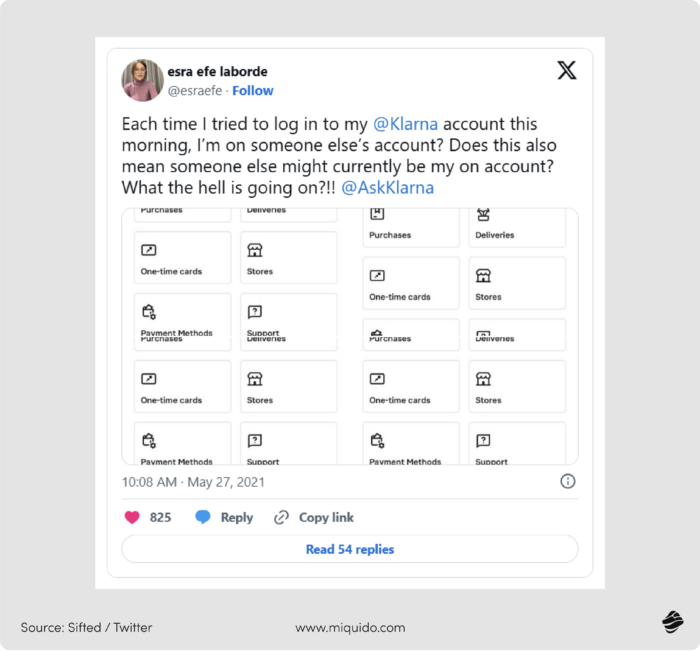
Payment fraud vulnerabilities
Payment fraudsters often exploit various vulnerabilities in mobile commerce apps. Emulators, phishing and social engineering, fake payment apps, reverse engineering to exploit security weaknesses, Man-in-the-Middle Attacks that intercept communications between the app and the server – all these risks apply to eCommerce apps.
In the case of successful frauds, the responsibility may not necessarily fall on you as a mobile commerce app provider. Everything depends on the origin of the vulnerability and the vector of the attack.
Take an example of Zelle. In December 2024, the Consumer Financial Protection Bureau (CFPB) sued major U.S. banks for failing to prevent fraud on Zelle. The lawsuit argued that banks ignored security gaps and customer complaints, leading to over $870 million in losses. The responsibility fell on the banks, not Zelle itself, due to inadequate fraud prevention measures.
However, in any case, such issues affect your reputation as a mobile commerce app provider. Better safe than sorry – make sure you check all the boxes of the list below when developing your m commerce application.
How to mitigate cybersecurity risks in mobile commerce
- Encrypt sensitive data: Use end-to-end encryption to protect user information from unauthorized access.
- Enforce multi-factor authentication: Require multiple verification steps to enhance account security.
- Conduct regular security audits: Identify and address vulnerabilities through frequent assessments.
- Train employees on security best practices: Reduce human error with ongoing cybersecurity education.
- Ensure compliance with regulations: Adhere to GDPR, HIPAA, and industry standards to avoid legal penalties.
- Detect and block emulators: Prevent attackers from mimicking real devices to bypass security.
- Use AI-driven fraud detection: Leverage machine learning to identify and stop suspicious transactions.
- Verify app authenticity: Prevent fake payment apps by enforcing app attestation and secure downloads.
- Secure communications: Encrypt transactions to protect against Man-in-the-Middle (MitM) attacks.
- Monitor user behavior: Detect anomalies in payment activity to flag potential fraud.
- Establish a rapid incident response team: Minimize financial and reputational damage with swift action.
- Communicate security measures to users: Build trust by educating customers on fraud prevention.
- Collaborate with financial institutions: Strengthen fraud detection through partnerships with banks and payment providers.
- Continuously update security protocols: Adapt to emerging threats with regular security enhancements.
User Experience limitations
UX is as important as performance in today’s mobile commerce landscape. Handheld mobile devices impose certain limitations due to screen size and touch-based navigation. Rule number one: every single bit of screen space is precious.
While UX issues are easier to avoid when designing mobile apps due to increased flexibility in mapping out the user journey, mobile websites should also be fully optimized for smaller screens.
Remember, while messaging apps, food delivery, mobile banking apps, and mobile payment apps have become a standard part of a mobile phone user’s toolkit, m-commerce apps are still not. A significant portion of your customers will try to shop through your responsive website, and you should accommodate their needs.
Here is what is worth paying attention to, whether you are optimizing a mobile app or a mobile website.
Small screen constraints
Shopping on a small screen can be a struggle—and, in the worst-case scenario, a reason to switch app providers. Misclicks caused by a cluttered interface and improperly sized elements can frustrate users, distracting them from the products—the perfect recipe for an abandoned cart. Your customer may have a hard time picking the right item or choosing the right settings, particularly if personalization comes into play.
A limited display area can mean fewer products per screen, requiring more scrolling and interaction. We are used to scrolling due to social media platforms, but it can still impact the shopping experience negatively, delaying the “aha” moment and even sabotaging the purchase.
A small screen often equals readability issues, especially in mobile websites. Small text sizes can strain users’ eyes, making information hard to read. That could result in misinformation and an increased number of claims and returns. Readability is also crucial to comply with data protection norms—users have to be able to easily review their information when using mobile wallets and other payment solutions.
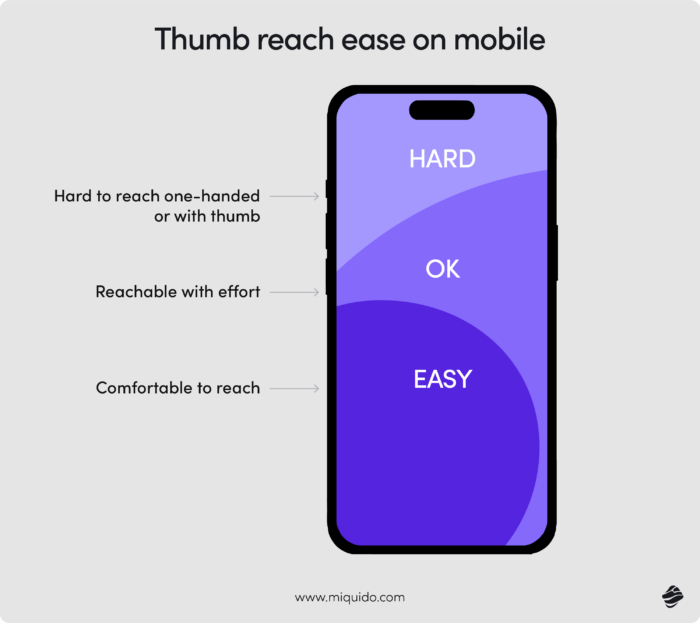
Complex navigation structures that aren’t optimized for mobile apps further contribute to the problem. A hidden search bar? Hard-to-find filters? Your users may switch to the competition faster than you expect.
Don’t forget that the increasing number of mobile phone users relies on voice navigation daily. Make sure to utilize reliable speech recognition APIs or voice assistant integrations compatible with your app’s platform. Ensure they support multiple languages and accents to cater to a diverse user base.
Universally recognized symbols, adequate spacing and sizing, and consistent navigation patterns—having these aspects taken care of, you reduce the probability of churn and increase the potential for conversion in m-commerce.
How to avoid user experience limitations
- Simplify interface: Declutter the app and ensure appropriately sized touch targets to prevent misclicks and reduce cart abandonment.
- Streamline product selection: Facilitate easy item selection and setting adjustments, especially in personalized shopping scenarios.
- Enhance readability: Use legible fonts and clear text to prevent misinformation and reduce return rates.
- Optimize navigation: Design intuitive structures with visible search bars and accessible filters to prevent user frustration.
- Integrate voice navigation: Implement reliable speech recognition supporting multiple languages and accents for users preferring voice commands.
- Use recognizable icons: Employ standard symbols, adequate spacing, and consistent navigation patterns to enhance user experience and increase conversions.
Device and platform fragmentation
Device and platform fragmentation is one of the biggest challenges in mobile commerce, with countless screen sizes, operating systems, and hardware capabilities to consider. Ensuring a seamless shopping experience across all mobile devices requires constant optimization and adaptability.
Compatibility issues
When Apple released iOS 16 in September 2022, many users reported crashes, freezing, and login failures in the eBay app. Some users were unable to complete transactions, while others experienced issues with search functionality and item listings not loading properly.
Reason? The app hadn’t been fully optimized for iOS 16’s system changes, leading to unexpected errors and making it impossible for the UI elements to load correctly. Although their impact is not precisely estimated, the issues with purchases and authentication likely had strongly decreased the margins despite eBay’s quick emergency update.
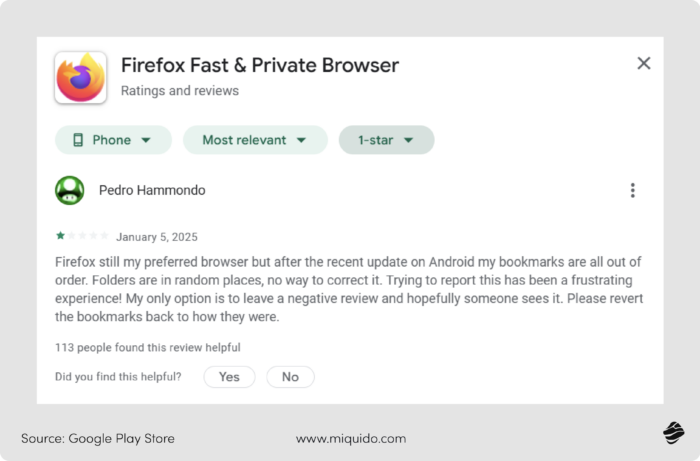
The incompatibility might manifest itselft as it did with eBay, but sometimes, it becomes a matter of choice. Take the example of Netflix, which announced in September 2024 that its app would no longer be compatible with Apple devices unable to update to iOS 17. Consequently, users of these devices could no longer receive new updates for the Netflix app, including critical security patches.
This move aimed to ensure optimal app performance and protect users from potential vulnerabilities. However, it also meant that individuals with older mobile devices faced limitations in accessing the latest features and security enhancements, underscoring the challenges that arise when apps do not maintain compatibility with evolving device updates.
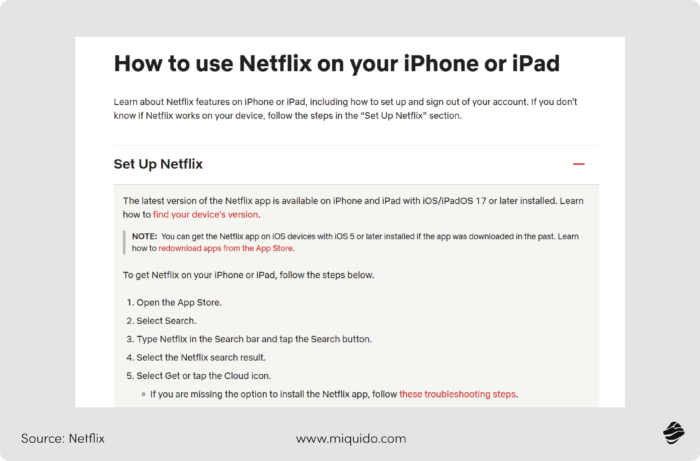
Consistency across platforms
You’ve probably heard the opinion that some apps work great on iPhones but are disappointing on Android—whether in terms of UX or performance. This is usually because one user base is significantly more important and profitable for the app provider than the other, making investments in improving native apps seem unworthy.
However, this can be a very misleading strategy. Users come and go, and the target group that once stood by you may migrate to another platform as soon as a more comprehensive solution emerges.
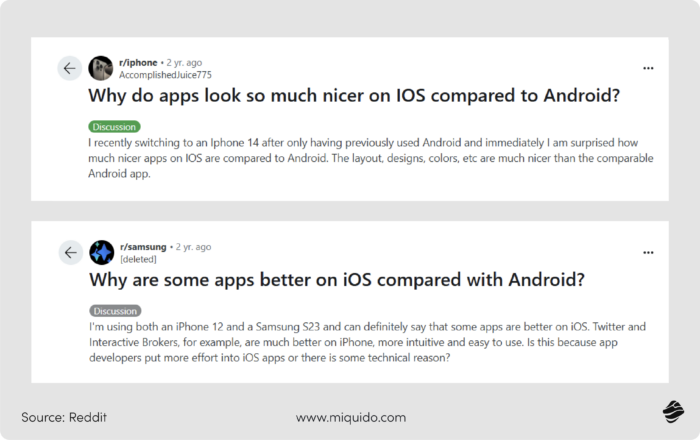
How to prevent compatibility issues
- Test for OS updates early: Regularly check beta versions of new operating systems to detect potential conflicts before release.
- Ensure backward compatibility: Optimize apps for older mobile devices to maintain access while balancing performance and security.
- Streamline UI adjustments: Adapt interface elements to accommodate system changes and prevent display errors.
- Prioritize security updates: Continue providing essential patches for users unable to upgrade to the latest OS.
- Monitor performance post-update: Track crash reports and user feedback to quickly address emerging issues.
- Communicate changes proactively: Inform users about compatibility limitations in advance to prevent frustration.
Connectivity and performance issues
Have you ever experienced frustrating delays or sudden disconnections while shopping on a mobile commerce app? Such disruptions can prompt users to abandon the app in favor of more reliable alternatives.
Performance and connectivity issues can stem from various factors, including inefficient code, server overloads, and poor network conditions. Addressing these challenges is crucial for retaining users and ensuring the success of your mobile commerce platform.
Network dependence
You’re rushing to buy a limited-edition sneaker drop, add the shoes to your cart, and hit “Checkout”—but the app freezes due to a weak network. By the time it refreshes, the sneakers are sold out, leaving you frustrated and empty-handed. Even if you have not experienced such situation yourself, hundreds of thousands of users daily find themselves struggling with it.
Network dependence in mobile commerce can turn a seamless shopping experience into a nightmare, leading to lost sales, abandoned carts, and frustrated customers. Whether it’s a flash sale, ticket booking, or even a simple grocery order, an unstable connection can mean missed opportunities and lost revenue. Although network quality is not something you have impact on as an app provider, taking preventive steps works in your favor.
Load time challenges
Mobile app providers know that for users, increased load time is like a red rag to a bull. Having a strong focus on preventing such situations, they have raised the bar high. Today, every such disruption is no longer considered just “part of the deal” but rather a problem worthy of being mentioned in a review in the app store or even prompting users to abandon the app.
It doesn’t matter that load time challenges can arise from various causes, not always dependent on the app provider:
- High server load during peak hours
- Poor network conditions on the user’s end (weak Wi-Fi, slow mobile data)
- Unoptimized code leading to performance bottlenecks
- Large media files increasing loading times
- Third-party service failures (e.g., payment gateways, authentication systems)
- Device limitations, such as low RAM or outdated operating systems
The case of the Starbucks app on July 30, 2024, demonstrates how even a short load time problem can have a huge impact and how much depends on timing and context. That’s when users across major U.S. cities, including Boston, New York, Washington D.C., and Los Angeles, reported significant issues with the app’s performance. The problems began around 8:30 AM ET, preventing customers from placing mobile orders and causing disruptions in their morning routines.
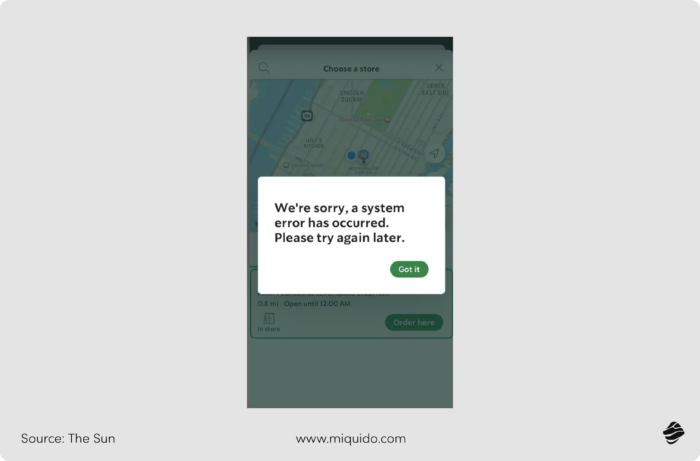
Approximately 90% of the reported issues were related to the app’s functionality, with additional problems occurring during login and checkout processes. The problem, which in many European or Asian countries would likely have gone unnoticed, caused a major stir in the U.S. The blame, of course, lies with American coffee culture—in the U.S., coffee shops open very early in the morning and primarily serve coffee to go, which customers order in advance.
How to overcome mobile commerce performance challenges
- Ensure OS compatibility: Regularly update and test for new operating systems to prevent crashes.
- Optimize backend performance: Use CDNs, caching, and load balancing to reduce latency and prevent server overloads.
- Minimize network dependence: Implement auto-retry for failed transactions and optimize data usage.
- Reduce load times: Compress media, prioritize critical content, and streamline background processes.
- Enhance stability: Monitor performance in real time and address issues proactively.
Environmental factors
Environmental factors significantly impact user experience in mobile commerce applications, especially as users often engage with these apps while on the move. Both usage context and the disruptions in-app or dev
Varied usage contexts
Elements such as noise levels, weather conditions, and lighting environments can all affect device usability. In optimal, quiet environments, modern speech recognition systems can achieve up to 97% accuracy. However, this accuracy drops substantially in high-noise environments.
Consider the scenario of shopping while commuting: navigating a crowded metro station presents a vastly different experience compared to shopping from the comfort of one’s home. In such a setting, ambient noise can render voice recognition features ineffective, and fluctuating lighting conditions may hinder screen visibility.
Similarly, attempting to browse products while walking outdoors exposes the user to varying weather conditions, which can affect touch screen responsiveness and overall device handling.

Screen visibility and adjustments are also crucial considerations. Implementing a dark mode in your app can enhance user experience, particularly in low-light conditions, and aligns with the growing user preference for features that support digital well-being. Providing a native dark mode ensures consistency and prevents potential user experience issues that may arise from relying solely on the device’s general dark settings.
How to adjust to various usage contexts
- Optimize voice recognition: Enhance the robustness of voice recognition features to perform reliably across different noise levels.
- Implement adaptive screen brightness: Allow the app to adjust screen brightness and contrast automatically based on ambient lighting conditions to maintain readability.
- Design for one-handed use: Ensure the app’s interface is navigable with one hand, accommodating users who may be multitasking or on the move.
- Provide offline capabilities: Enable certain functionalities to work without an active internet connection, catering to users in areas with poor connectivity.
- Offer customizable display settings: Allow users to personalize font sizes, contrast levels, and color schemes to suit their preferences and environmental conditions.
Distractions and interruptions
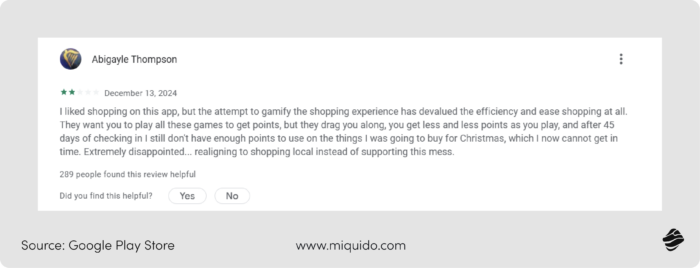
Payments in mobile commerce
Trust issues with mobile payments
Payment frauds are becoming more frequent. Users may approach new mobile commerce apps with limited trust, having experienced scams or heard about them.
Think of a frequent scenario that has been repeatedly seen in Airbnb and Booking. A traveler finds a perfect listing at a great price. The host, seemingly legitimate, asks them to finalize the payment outside the platform, directing them to what looks like an official Airbnb page. Unknowingly, the guest enters their payment details into a mirror website. The booking disappears, the scammer vanishes, and the victim is left without recourse.
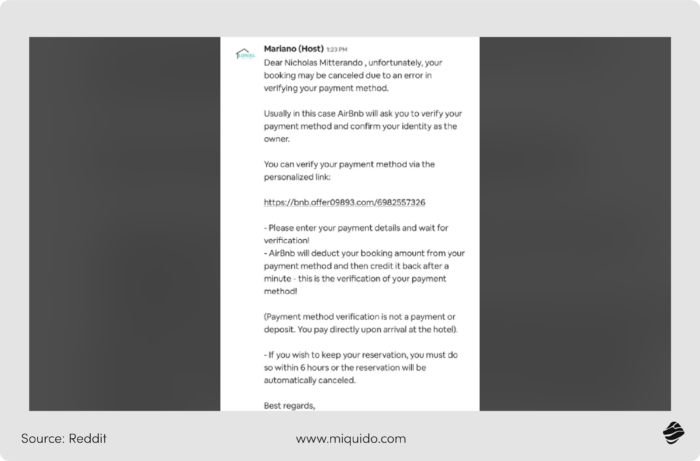
Even though such scams in mobile commerce are rarer than in payment or travel sector, scammers may create counterfeit mobile sites or applications that closely resemble legitimate shopping platforms. These fraudulent sites aim to steal personal and financial information.
Scams often undermine the reputation of the mobile app provider, as happened with Zelle. Users reported cases where fraudsters tricked them into sending money for fake products or services. Since Zelle transactions are instant and irreversible, victims found themselves unable to recover their funds, leading to backlash against the platform.
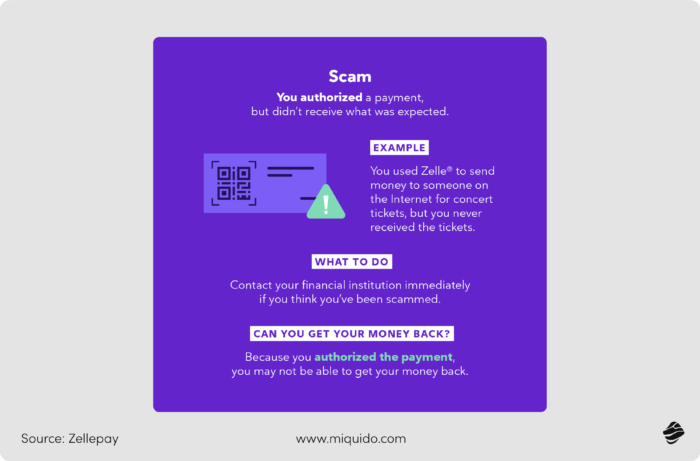
How to solve trust issues with mobile payments?
Although scams, especially those involving mirror websites, may be hard to avoid, you can take preventive steps by following examples from business leaders.
- In-app alerts and push notifications can warn mobile users about common fraud tactics before they finalize payments.
- Gamified quizzes on scam awareness can make education more engaging.
- Social media campaigns featuring real-life scam stories can help users stay vigilant and protect their transactions.
What to recommend? Above all, sensitize your users to correct URLs, as well as security indicators like “https” and a padlock icon. Instruct them to avoid clicking on links or providing information in response to unexpected emails or messages. Implementing generative artificial intelligence-based
Integration with multiple payment gateways
Multiple payment options is a must for a competitive mobile commerce, but it comes at a cost. Integrating multiple payment gateways means challenges, increasing complexity in payment processing. It also requires the mobile app provider to implement robust security measures to protect user data.
Take a look at Uber, which integrates multiple payment gateways, such as Braintree and Adyen, to process transactions within their mobile app securely. This approach allows users to pay without leaving the app, providing a seamless payment experience.

How to protect multiple payment gateways?
In the EU, strong customer authentication is an obligatory step since 2020, but you can employ additional measures to protect multiple payment gateways.
- To protect sensitive information from interception during transmission, you can implement strong encryption using robust protocols like Secure Sockets Layer (SSL) or Transport Layer Security (TLS).
- To ensure the secure handling of cardholder information, comply with the Payment Card Industry Data Security Standard (PCI DSS), which includes maintaining secure networks, protecting cardholder data, and implementing strong access control measures.
To significantly reduce unauthorized access, implement Multi-Factor Authentication (MFA), requiring users to provide two or more verification factors, such as passwords and biometric data.
Let’s tackle mobile commerce challenges head-on
We’re stronger together! As you can see, we understand the mobile commerce challenges and have optimized various apps for mobile devices, ensuring their long term success. Whether it is about discovering tendencies in a particular region, like mobile commerce trends UK or ways to increase mobile app conversion rate, we have you covered.
Conquering ecommerce industry and finding a pathway to the hearts of mobile shoppers does not have to be a lonely journey. Join forces with a reliable e-commerce partner!

![[header] challenges of mobile commerce](https://www.miquido.com/wp-content/uploads/2025/02/header-challenges-of-mobile-commerce.jpg)


![[header] case study enhancing mobile app performance and loyalty program efficiency in grocery retail](https://www.miquido.com/wp-content/uploads/2025/04/header-case-study_-enhancing-mobile-app-performance-and-loyalty-program-efficiency-in-grocery-retail-432x288.jpg)

![[header] off the shelf vs. custom ecommerce software](https://www.miquido.com/wp-content/uploads/2020/05/header-off-the-shelf-vs.-custom-ecommerce-software-432x288.jpg)

![[header] challenges of mobile commerce](https://www.miquido.com/wp-content/uploads/2025/02/header-challenges-of-mobile-commerce-432x288.jpg)